I would bet that your guided reading minutes are precious to you – right? Mine always are, anyway. When you have a large (or even medium-sized) class of students to teach, guided reading is essential for reaching students at their instructional levels.
Since guided reading is so valuable, we have to be very intentional about what we are teaching during that time. I’ll be the first to admit that, during my first few years as a classroom teacher, I was a bit scattered in the content that I was teaching during guided reading. (When I say content, I mean strategies – like “Chunk the word” or “Read the table of contents before you begin reading the text” or “Think about who the characters in the story are.”)
I always used student data and observations to determine what I was teaching, but sometimes I either a) didn’t teach one strategy long enough for students to master it or b) didn’t teach certain strategies that would have benefitted my students.
I found that it was important for me to find a system for tracking what strategies I was teaching students over time (taking into account that some students will change guided reading groups during the year). I also found that I needed to have some sort of guiding list(s) to draw from when I was choosing a strategy to teach during my lessons. In today’s post, I’ll share how I systematically track what I teach students during guided reading. I’ll also share how I figure out what to teach in the first place!
Note: This post contains an Amazon affiliate link.
 Tracking Instruction Over Time
Tracking Instruction Over Time
Recording what strategies you’ve taught each individual student is sort of a pain in the you-know-what, but it really is valuable. I, for one, do not have a mind like a steel trap. It’s easy for me to forget what I’ve taught and when I taught it!
To track my instruction over time, I use a simple spreadsheet. Here is one possible way to set it up:
First, type in the skills you want to teach in the top row of the sheet. Students’ names are inserted down the side, in the first column.
When you make your guided reading plans for the week (or look over them when the week is over), you can find each student’s name and then fill in a date under the skill that you taught them during guided reading.
If you use this style of spreadsheet, you might want to use different tabs (sheets) for decoding skills, fluency skills, fiction comprehension, and nonfiction comprehension. Otherwise you may end up with a reaaaaallly long row up top! If you want to try this out, click on the image below to download it for free.
Another way of setting it up would be to put dates in the top row of the sheet. Students’ names are written down the side, in the first column.
Each week, you just type in whatever strategy you worked on that week with the student during guided reading and/or reading conferences. Using the copy and paste functions (and shorthand for naming the strategies) will save you a ton of time here. 🙂
Or, if you use any of my guided reading packs or bundles, you already have a spreadsheet all set up for you, with appropriate strategies for the level – all you need to do is make a mark when you teach a strategy!
You can see my guided reading resources HERE.
Determining What To Teach
Setting up the spreadsheet is the easy part. What’s more challenging is figuring out what strategies you need to teach throughout the year.
When I’m figuring out what strategy to focus on during guided reading, I typically pull from three different places:
- My notes on students’ current strengths and needs. If I find that many of the students in a guided reading group are, for example, not self-correcting errors, that tells me that I need to spend several lessons teaching them how to do this. Below are some photos of different anecdotal note forms I’ve used to keep track of students’ progress (both forms are from my guided reading packs):
This last photo shows level-specific checklists, which are part of the guided reading packs AND also available separately for Kinder, 1st, and 2nd.
- The overall goals for the reading unit I’m teaching to the entire class. Is the whole class working on nonfiction? Maybe you want your kids to use text features, ask and answer questions, and find the main idea? Guided reading is a great time to address those same skills. It’s helpful to keep a list of your unit skills/strategies on hand, so that you can also address those skills during guided reading and individual reading conferences (in addition to your whole group lessons).
- A list of the challenges of each reading level. In order to figure out what to teach students, we need to understand how this particular level of text is challenging them. Do they need to follow dialogue? Infer a moral when not explicitly stated? Knowing this information helps us figure out what to teach students so that they can successfully decode and comprehend that level of text. Also, we know that when a text goes from, say, Guided Reading Level K to L, the text gets harder. But how, exactly, does it get harder? If you’re not aware of the differences between each level, it’s going to be more difficult to teach your students to read more challenging text. However…I’m not advocating that you spend your winter break staring at leveled books. 🙂 All you need to do is to get access to this book:
The Continuum of Literacy Learning is an AMAZING resource! If you have the Fountas and Pinnell Benchmark Assessment System in your school, you probably have this book, too.
The Continuum gives an in-depth analysis of the characteristics of each level of text for Guided Reading Levels A-Z. There’s so much information that you could get bogged down in it. Just focus on the challenges of each level of text (what students are working on mastering at that level) and how those challenges change between levels.
Here’s an example:
The Continuum describes a Level B text as having “short, predictable sentences that are close to oral language” (Pinnell & Fountas, p. 256). However, a Level C text is described as having, “simple, predictable sentence structure but varied patterns” (Pinnell & Fountas, p. 260).
In plain language, this means that the sentences in a Level B texts pretty closely follow a pattern, while the sentences in a Level C text are more varied in structure.
As a teacher, this tells me several things about working with students whose instructional level is B. It tells me that I need to help readers pay close attention to the pattern in the text, so that they are not repeatedly trying to decode words that appear again and again in the book. It also tells me that in order for my students to be ready for Level C text, they need to learn to rely on sight words and decoding rather than just following a predictable text pattern.
I could go on about how awesome the Continuum is, but I’ll contain myself. 😉 Basically, it’s a great tool for helping you figure out what skills a student needs to master to successfully read a book at a certain level. It also shows you the differences between different text levels, so that you can help students move forward with their reading.
In a Nutshell
Today we’ve talked about the value of tracking what you teach during guided reading over time. We’ve also discussed three different things to take into consideration when planning what to teach during guided reading – students’ needs and current ability levels, your goals for your current class-wide reading unit, and the challenges of the text level that students are reading.
I know that this seems like a lot to think about when planning just one small part of your day. And it is…it’s a whole lot. Try to simplify things for yourself by using one of the spreadsheets in this post, using pre-made formats for taking anecdotal notes, and getting a copy of The Continuum of Literacy Learning.
Although Guided Reading takes a while to plan, the work certainly pays off. If you need resources to support your guided reading instruction (with a clear scope and sequence of what to teach), check out my guided reading bundles (individual levels and other bundle options are available HERE):
Happy teaching!
Resources:
Pinnell, G. S., & Fountas, I. C. (2008). The continuum of literacy learning, K–8: Behaviors and understandings to notice, teach, and support. Portsmouth, NH: Heinemann.

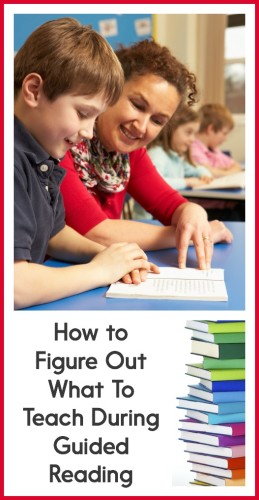 Tracking Instruction Over Time
Tracking Instruction Over Time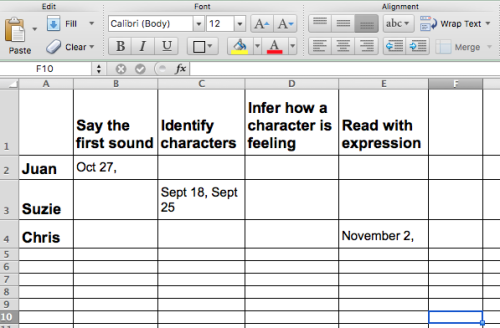
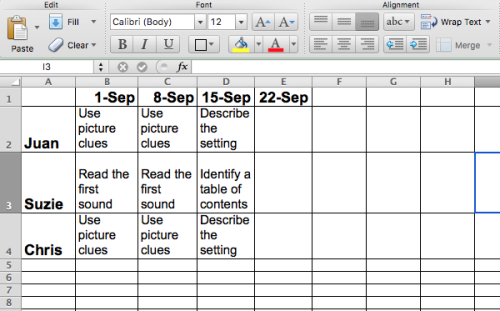
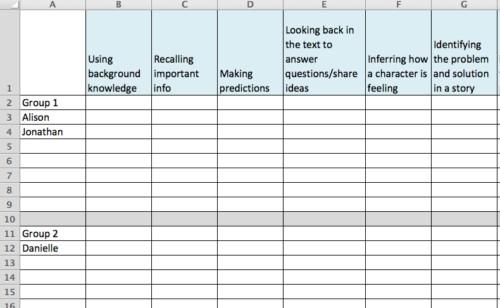
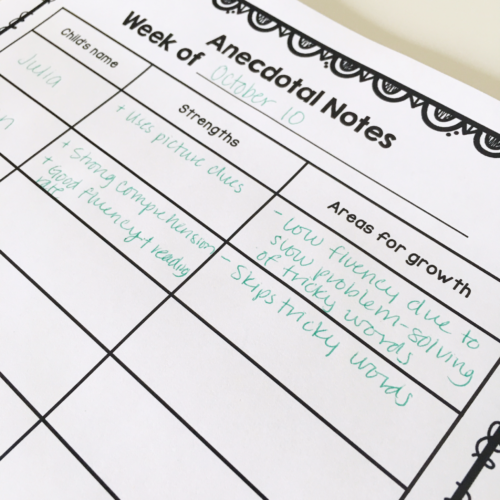
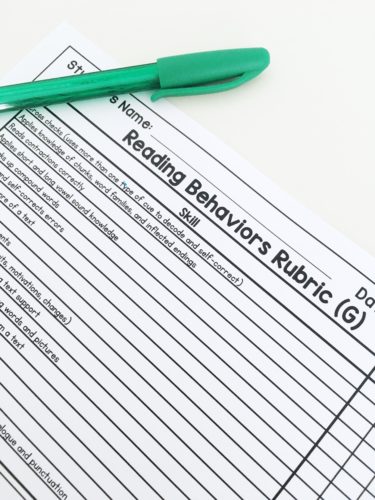

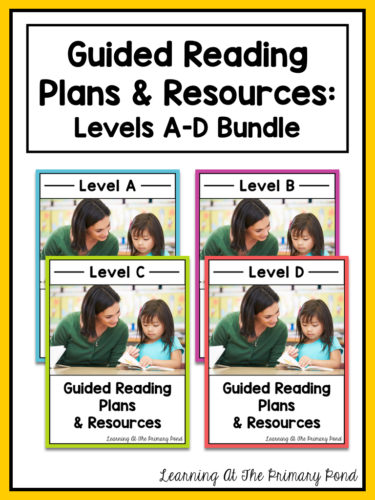
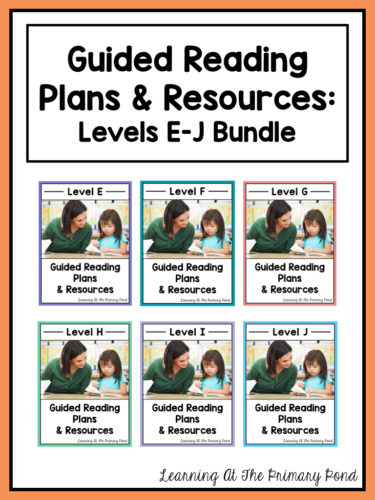
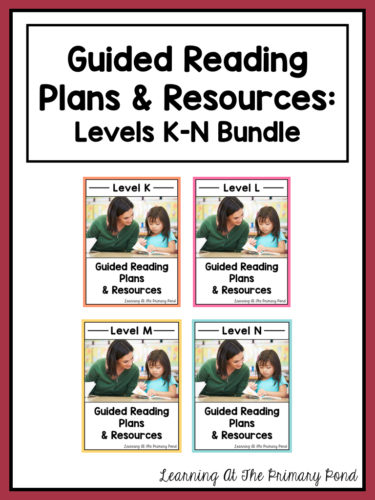
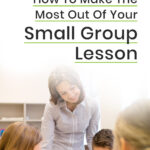
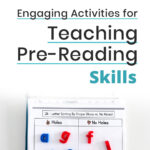
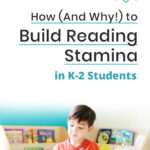
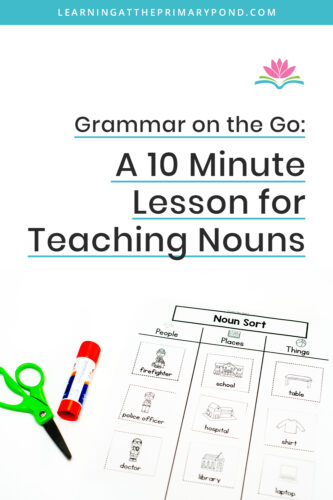
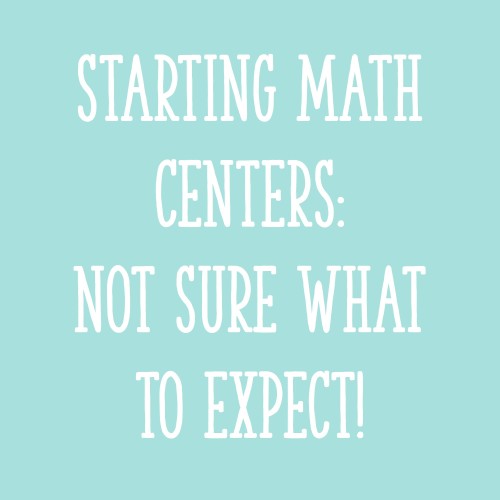







Do you have the readers workshop toolkit in Spanish? I’m using your fluency ladders for both of my dual language classes and they love them!Thank you for sharing.
Hey Elizabeth! So glad your kids love the fluency ladders!! While I don’t have the full reader’s workshop toolkit in Spanish, I do have all of the strategy posters in Spanish for the K-1 toolkit. They can be found here: https://www.teacherspayteachers.com/Product/Spanish-Reading-Strategies-Posters-and-Cards-Estrategias-de-lectura-en-espanol-2140490
If you have any questions, feel free to email me. Thanks for your interest! 🙂
Alison
This may seriously be the most helpful blog post I have read. This is my third year teaching and guided reading is something I have strived to do well at, but struggled to find a hood way to organize and figure out what to teach. Thank you so much!!
I’m so glad that’s helpful, Brooke! I can totally relate with struggling to figure it out…you’d think GR would be easy to plan for since it’s just 15 or 20 minutes with a group, but it still takes a long time. Thanks for commenting! 🙂
Alison
I totally agree with Brooke! I am just finishing up my first year of teaching, and I have struggled all year with guided reading! This was so helpful, thank you so much for these great ideas and resources! I just downloaded the guided reading checklists and rubrics, and I’m excited to try them out! Thanks again!
I am so glad this is helpful!! Congrats on finishing your first year!
Alison
Thank you, this post is so helpful! I’ve been struggling with guided reading, and I feel like I have a direction and plan to follow now.
I am so glad to hear that, Beth! Let me know how it goes. Thanks for reading and commenting! Alison
Great post! Do you have this for upper elementary grades?
Hi Michelle, unfortunately I do not. My experience is all in preschool through 2nd grade. Sorry about that! Alison
Thank you for your insight into guided reading. Your tips are useful and very well organized. After twenty five years teaching, I’m still adjusting my teaching style. ?
You are so welcome, Nathalie! I think we are all in a process of constant adjustment and refinement – which I think is a good thing! 🙂
Alison
Hi Alison – Quick question…I teach 2nd grade and have both the K-1 and 2-3 Reading Workshop Toolkit in my cart. I was wondering if there was enough difference between the two to be worth getting them both? I was think I would use the K-1 packet’s materials for my low readers? Thoughts? Thanks so much!!
Hey Shannon! I might get the 2-3 toolkit first – there is definitely some overlap between the two products. If, after looking everything over, you feel that your lower readers would need something different, then the K-1 toolkit would help. Let me know if you have any other questions!
Alison
I agree tracking what you’ve taught your students and teaching skills in a systematic and organized way is very important. But I question what you’re teaching. The foundational building block of reading is sounds. Without automaticity of sounds, saying them, writing them, and blending them many students will have a difficult time learning to read. We shouldn’t be teaching students to look at only the first sound and then guess. We shouldn’t be using picture cues as a way to figure out new words. It is not an effective strategy. Students should be doing a sound drill every day. They… Read more »
Thank you for sharing your thoughts, Amy! I agree that systematic phonics instruction is very important. It just wasn’t the focus of this particular post. We work on phonics during guided reading, but guided reading is also a time for reading connected text. When we’re reading, I encourage students to consider both phonics cues and meaning cues.
Alison
Hello! I am a first grade teacher. A parent also a teacher doesn’t agree with the reading level I have assessed her child. Any suggestions?
Hi Jocelyne! What assessment did you use? (i.e. Fountas and Pinnell Benchmark Assessment, DRA, running record, etc.)
Alison
Hi,
Do you offer just the Anecdotal Notes about _____’s reading seperatly? I’m currently working as a small group teacher and I pull groups for Guided Reading and LLI and was struggling with the ANecdotal Records and that paper seems like it would help so much! Any suggestions would be appreciated! Thanks, Dana
Hey Dana, if you just need that sheet, no problem! Email me and I’ll send it over. 🙂
Alison
Is there a way I can also get just this page? I would really LOVE this for my guided reading binder!
Hey Ashley! Email me and let me know which page you’d like. 🙂
Alison
Alison@learningattheprimarypond.com
Brooke, Meghan and Beth nailed it! Thank you thank you thank you for guiding me in the right direction! I feel more confident for having read this blog! I own the Continuum (highly suggested purchase when I was doing my BEd, so i bought it!) but I haven’t really taken the time to get to know its value. This resource and I are getting together this weekend. Thanks too for the tracking pages.
Yay, Daisy! I’m so glad this helps!! Have fun diving into the Continuum! 🙂
Alison
Alison, I was wondering if you had made a guided reading package for third grade? Thanks:)
Hey Dawn! Not at this time, unfortunately – sorry about that!
Alison